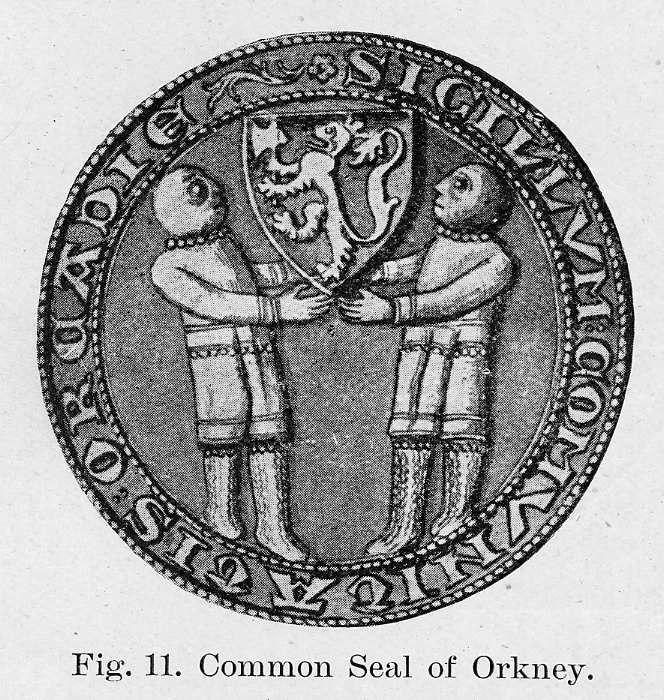Orkney Coat of Arms

An impression of the ancient seal of the ‘Communitas Orcadie’, c1425. It shows the Norwegian Royal Arms being supported by two men. These figures are likely to be ‘Best Men’, members of the Orcadian aristocracy who would have sat in the public law court or ‘lawthing’. Orkney was one of only two Norwegian provinces, which had been granted permission to use the Royal arms on their seal.

Due to the existence of the old seal, the County Council was recognised as the legal descendants to the ‘Communitas Orcadie’, which allowed it to matriculate its arms as ‘ancient user’ under the Act of 1672. This recognised Orkney’s coat-of-arms as the most ancient public authority arms in Scotland.
On the left side of the shield there is the gold galley on a blue background, representing the ancient Earldom of Orkney. The right side of the shield has the Royal arms of Norway, the lion rampant with a battle-axe on a red background, which recalls that Orkney was once a Norwegian province. At this time the Latin motto ‘Boreas Domus Mare Amicus’ (The North our Home, the Sea our Friend) was chosen and added to the compartment, or base. The shield has two supporters, thought to be 15th century udallers or free land-owners under the udal system of land tenure. They are dressed in their best clothes (braws) and are wearing seal skin boots.

In 1975 the Orkney County Council became the Orkney Islands Council due to local government reorganisation. The Council was allowed to take over the 1931 coat-of-arms but with a couple of changes. The shield is topped with a coronet, appropriate to a statutory Islands Area, richly decorated with four dolphins, two of which are visible. One of the udaller supporters was changed to a Scottish unicorn, which wears a badge with the Scottish Saltire on its collar. It is common to all the Islands Councils’ coats-of-arms.

The cathedral town of the old diocese of Orkney was designated a Royal Burgh by King James III in 1486. The arms, which follow the device on the 1675 Burgh seal, use the blue and gold colours of the ancient Earldom of Orkney. The three-masted ship denotes that Kirkwall is an important seaport. The Latin motto ‘Si Deus Nobiscum’ translates as ‘If God be for us’. The current seal was adopted in 1890 and was designed by the local architect T.S. Peace.

Stromness became a Burgh of Barony in 1817. This freed the Stromness merchants from having to pay taxes to Kirkwall for engaging in foreign trade. A prolonged legal battle had been fought, eventually the House of Lords decided in favour of Stromness. This freed all small towns and villages in Scotland from being tributaries of the Royal Burghs.
Stromness became a Police Burgh in 1856. Its seal shows a Norse dragon-ship, and a small pair of scales to recall the successful legal battle mentioned above. The Latin motto ‘Per Mare’ means ‘of the sea’, or ‘the sea bringing life and fortune’.


Above are the two coats of arms for Orkney, made of fiberglass by Harry Berry. Harry lived in North Walls on the island of Hoy and was also responsible for making Betty Corrigall’s grave marker, which is also made from fiberglass but resembles a carved stone.

To make a donation to any of the museums please follow the link and support us. Thank you.
